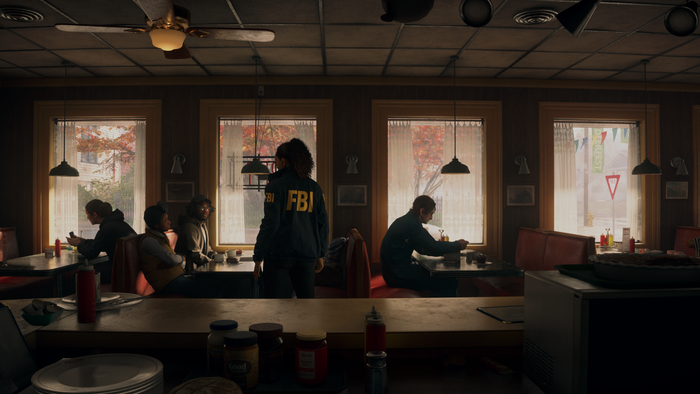
A funny thing happened when I sent questions over to Alan Wake 2 composer Petri Alanko. After he sent over his responses, I had the uncanny experience of realizing they sounded like something Alan Wake himself would write.
“The duality of it all is always there, hanging like a heavy cloud. The Dark Place starts, little by little, leaking into our world, 'poisoning' all the events here in our normal world,” he said. "The border between the two places is very clear in the beginning, but the line blurs and blurs, until only a haze remains."
You can imagine these words being uttered in Matthew Porretta’s gravely tones as the clack of a typewriter rings out.
Alanko has been the composer on every game in Remedy’s shared universe since the original Alan Wake—a series he would have been right in thinking he'd never return to. In 2013 creative director Sam Lake declared that the game had not sold well and a sequel was not coming.
It seems Lake had to eat his own words. Three games and 13 years of experience later, Alan Wake 2 is here. For Alanko, it’s a project that's been in the works since 2011.
13 years in the Dark Place
“I wrote the first tracks for a sequel back a year after the first Alan Wake,” Alanko said. “I actually forgot a lot of what I had [originally] written. Until I went through my backups four years ago, when the signs of Alan Wake 2 finally started to appear.”
Remedy is a studio many in the industry would consider lucky. As its ambitions get larger, so do the budgets, in this instance thanks to the studio’s benefactor Epic Games, who funded Alan Wake 2’s development.
“In the first Alan Wake, I was using only a string orchestra (with an occasional oboe), but here things needed to be very different,” Alanko said. In the sequel, he said the hardest challenge was scoring Alan's mental state. The composer wanted to convey an Alan that had spent 13 years in the Dark Place—the ways it had altered his mind.
In defining the sonic identity of the Dark Place, Alanko used brass instruments and altered their natural sounds. “How would instruments sound like if they were played underwater,” was a question he asked himself.
To create the more demonic sounds of Alan Wake 2, he built a device from a 1950s enamel washbowl to process the brass through. “I attached piezos and contact mics to it and fed sounds through it,” he said, “ I made a set of impulse responses from it, which I then used in every single possible convolution plugin I could possibly get my hands on.”
Alanko also used an instrument with a name straight out of an Alan Wake novel—the Apprehension Engine and The Mega Marvin. The former is a large stringed instrument that Alanko calls a beautiful wooden beast. It was created to make sounds for horror movies. Alanko spent hours trying to get the most appropriately murderous samples from the device, which was custom-made for Alan Wake 2.
“That machine oozes horror,” the composer said.
Scoring Alan Wake 2 wasn’t just about Alan. You spend more time in the game playing as new protagonist Saga Anderson, who occupies the real world in Bright Falls.

Image via Remedy.
“With Saga, the music is at first rather acoustic and melancholic. With Alan, there's the Dark Place roaring all the time,” Alanko noted the differences between the two but pointed out that creating a binary was not his intention. Instead, as the story progresses the worlds bleed into one another. “As the blurring goes on long enough, they sort of merge, until the worlds and the aesthetics separate towards the game's key point[s].”
To contrast them cleanly, the Dark Place is a celebration of enharmonic tones and dissonance, while Saga’s reality of Washington State stays serene and innocent.
Alanko uses music to link the “Remedy Connected Universe”
Alanko has been working with Remedy for nearly two decades at this point. Development on the first iteration of Alan Wake had begun immediately after Max Payne 2: The Fall of Max Payne was released. As early as 2004, Alanko was working on tracks for Remedy. One of those unused 2004 compositions even made its way into the score for Alan Wake 2.
When it comes to working with Remedy, Alanko compared it to winning the lottery. The emotional input he got from the team during their “cinematic reviews” was an experience he’d never had anywhere before.
“They encourage people to discover,” he said, specifically referring to Remedy’s approach to testing and prototyping. “it creates a safe place to challenge your own ideas and you try even harder to enter the areas you've shied away from previously.”
Alanko is a genuine fan of the Remedy Connected Universe. He loves the studio’s ambitions, as evidenced by a tattoo of concept art from Control on his arm. “I'm thinking about doing another sleeve with Alan Wake 2,” he said.
The images inspire the music, but both of them, in tandem, create a world. Alanko is one of that universe’s architects. He admittedly places references to older games in his scores.
In one Alan Wake 2 moment, a dead Nightingale wakes up in the morgue. Immediately before this, sheriff Tim Breaker disappears out of thin air. Clues throughout the game point to this character being a mirror of the same character actor Shawn Ashmore played in Quantum Break. The score gives even more credence to this theory
“The noise percussion [that accompanies that moment] is a Kontakt patch I made for Quantum Break.” Alanko pointed out. “There are a few more, here and there, each an homage for a past Remedy IP.”
“I guess the only one missing is Death Rally.”
About the Author
You May Also Like









